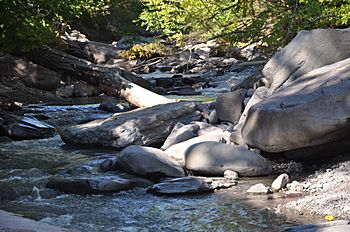Saw Kill (Esopus Creek tributary) facts for kids
Quick facts for kids Saw Kill |
|
|---|---|

Saw Kill near Woodstock NY
|
|

Map of Esopus Creek and its watershed
|
|
| Country | United States |
| State | New York |
| Regions | Catskills, Hudson Valley |
| County | Ulster |
| Physical characteristics | |
| Main source | 42°05′48″N 74°05′33″W / 42.096757°N 74.0923619°W |
| River mouth | Esopus Creek By Kingston 121 ft (37 m) 41°58′52″N 74°00′29″W / 41.9812031°N 74.0081941°W |
The Saw Kill is a river in New York State. It flows for about 19.7-mile-long (31.7 km). This river is a main branch, or 'tributary,' of the Esopus Creek. The Esopus Creek then flows into the Hudson River.
Contents
Where is the Saw Kill?
The Saw Kill is located in Ulster County, New York. It starts high up on the slopes of Indian Head Mountain. The river then flows through the town of Woodstock. Finally, it joins the Esopus Creek near Saugerties.
The Saw Kill is one of the most important rivers that feed into the Esopus Creek. When the Saw Kill meets the Esopus, it leaves behind a lot of sand and dirt. This shows that the Saw Kill carries a lot of sediment.
What is the Saw Kill Watershed Like?
Most of the land around the Saw Kill is covered by forests. This area is called the watershed. A watershed is all the land where water drains into a particular river. The Saw Kill watershed also has some wet, marshy areas known as wetlands.
History of the Saw Kill
Early Land Purchases
In 1765, a man named William Legg bought about 100 acres of land. This land was on both sides of the Saw Kill. He paid for it with 50 "schipples" of wheat. This was one of the first land sales in what is now Kingston.
Legg built a sawmill and a house on the land. He also had to pay a small amount of wheat each year to the people he bought the land from. The Legg family lived there for 88 years. They even ground wheat at the mill for the American army during the Revolutionary War.
Mills and Quarries
Later, James Gaddis owned the land. He continued to run the mill. In the 1880s, a fire destroyed both the house and the mill. To rebuild, Gaddis allowed people to dig for "bluestone" near the Saw Kill. Bluestone is a type of rock. This digging, called quarrying, moved the nearby waterfall back by 300 feet.
Another mill, called Howe’s Mill, was also on the Saw Kill. It used a dam to power its machines. This mill made gunpowder, so explosions happened often. Even with explosions, the mill kept working until it was hit by lightning in the 1860s.
Bluestone Mining and Communities
Bluestone quarrying grew a lot after 1828. This was when the Delaware and Hudson Canals were being built. Quarry owners hired many workers, often immigrants, and built homes for them. This created small, unique communities of different cultures. Many of these old houses are still standing today.
Tourism and Flooding
In the 1900s, railroads made it easier for people to visit the area. Many farmers would rent rooms to city visitors during the summer. People loved the beautiful scenery and good trout fishing in the Saw Kill.
As more people moved to the suburbs, new neighborhoods grew near the Saw Kill. This caused problems with flooding when the river overflowed. In 1981, residents tried to clean out the creek to stop the flooding. However, flooding still happens during heavy rains.
Saw Kill Ecosystems
The Saw Kill is an important home for many different animals and plants. Where the Saw Kill meets the Esopus, there are flat areas with pools of water. These pools used to be sand or gravel pits. Now, they are a great home for frogs, including the Northern Leopard Frog. This frog is rare in the area. Other creatures like dragonflies and small fish also live here, creating a healthy ecosystem.
Water Quality of the Saw Kill
Sometimes, the water in the Saw Kill has had problems. Tests near Lake Katrine have shown high levels of bacteria. These bacteria levels are usually worse after heavy rainfall.
Fun Activities on the Saw Kill
The Saw Kill is a great place for outdoor fun! You can find exciting whitewater rapids for rafting and kayaking. There are also swimming holes where you can cool off. Many people also enjoy fishing in the Saw Kill.

